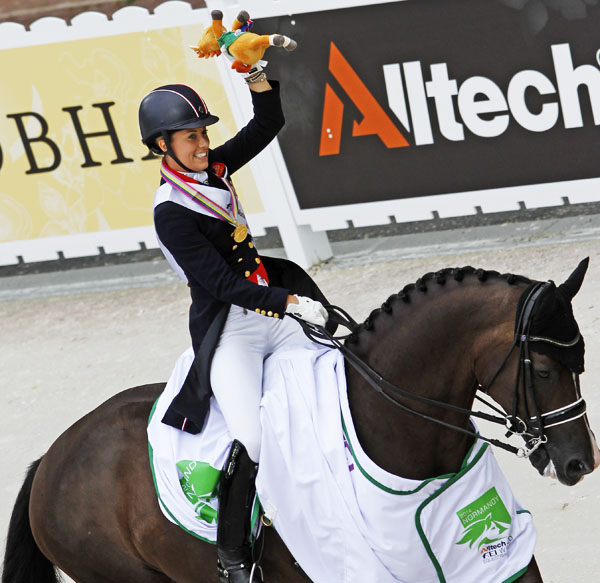Qualifying Begins Jan. 1 for Tryon World Equestrian Games–By the Numbers–Part 2 of 3
8 years ago StraightArrow Comments Off on Qualifying Begins Jan. 1 for Tryon World Equestrian Games–By the Numbers–Part 2 of 3

By KENNETH J. BRADDICK
Qualifying for the 2018 World Equestrian Games at Tryon for dressage and most other equestrian disciplines begins Jan. 1 with the American organizers projecting a record number of horses and riders competing at show grounds that did not even exist two years ago.
Preparation are being made for 840 horses to compete in the world championships of dressage, driving, endurance, eventing, jumping, reining and vaulting plus another 100 for para-equestrian for the games to take place at Tryon International Equestrian Center Sept. 10-23, 2018.
The total compares with 803 horses in the seven sports excluding para equestrian at the 2014 WEG in Normandy that set a record for participants and an increase of 56.7 per cent over the 536 horses in the seven sports at the 2010 championships in Kentucky.
The number for dressage is put at 90 horses that is 10 fewer than the 2014 WEG in Normandy but a third more than the 66 in the 2010 Games, the first time the championships were staged outside Europe since the first event in 1990 and held once every four years.
The horses are scheduled to fly into the Greenville/Spartanburg international airport about 45 minutes from the Tryon show grounds in Mill Spring, North Carolina in the foothills of the Blue Ridge Mountains.
Charlotte Douglas International Airport, where most visitors from the Americas as well as the rest of the world are expected to arrive, has direct flights throughout North America and to Europe and Central America.
Although qualifying criteria for dressage in 2018 has not yet been decided, the make up will be the same as previous WEGs of four riders and horses with three scores counting for teams, and not the newly adopted Olympic format of three combinations with no drop score.
The minimum requirement to qualify is expected to be scores of 64 per cent at two different CDIs at 3* level or above, though each nation will set its own qualification standards to approve participation of athletes and horses.
Some nations are exploring the possibility of taking advantage of the schedule of international events at Tryon leading up to WEG to make final decisions on qualification of teams.
The Tryon facility did not exist on any international equestrian calendar two years ago, it has become a major attraction having grown already to about 40 horse shows a year.

Although on the list of the top show grounds in the world sponsored by Rolex, the Swiss watch and timing company stepped aside so that Tryon could keep alive the International Equestrian Federation (FEI) banner event that is contractually sponsored by Longines after Bromont in Canada pulled out with just two years to go to the 2018 event.
About $125/€96 million has already been spent by the private partnership that owns the facility on 1,600 acres (650Ha) with another $50 to $60/€48-57.6 million tossed in as an operating fund for the next couple of years.
Built already are 1,200 permanent stables, 12 arenas including the floodlit George Morris centerpiece stadium with spectator seating up to 12,000 and VIP seating for up to 1,500 but more if needed, a covered arena (to be enclosed) with 5,000 seats and an eventing cross country course designed by Britain’s Mark Phillips that some participants in this year’s American eventing championships declared it could rank among the world’s best.
Most questions have come over hotel/motel accommodations close to the show grounds, a situation not unlike Bromont where Montreal was the closest city with most rooms available, well over an hour away from the show grounds.
About 12,000 hotel/motel rooms are in Charlotte, a major commercial hub about 80 miles/128 km or 90 minutes on Interstate highway from the show grounds at Mill Spring.
Within about 45 minutes west are 6,000 rooms in the mountain tourist city of Asheville and about the same distance south another 5,000 rooms in Spartanburg/Greenville, South Carolina. Another 6,000 rooms are within 30 minutes of the TIEC.
College student accommodations have been reserved at a nearby college to accommodate media and officials, similar to affordable housing for many in the media and officials at the equestrian competition at Greenwich Park at the London Olympics in 2012.
By the time WEG rolls around in September, 2018, the 200 rooms in multi-bedroom condominiums and upscale motel style buildings already in use will be expanded by the organizers to accommodate 1,200 grooms and as many riders as possible all on the show grounds.
Mark Bellissimo.who heads the organizing committee as well as majority partner in the ownership group, has set up a computerized 60,000-square foot factory to prefabricate homes.

Organizers and state government officials project more than 500,000 visitors over the 14 days of WEG, but the numbers are difficult to make comparisons with previous games. The economic impact was projected by the former North Carolina governor at more than $400/€385 million.
Normandy in 2014 reported 574,000 spectators, but 428,000 tickets were sold for sporting events. Economic impact was reported as €368/US$414 million for France, including €102/US$114.8 million to Normandy. The Games made a profit, including covering public funding of €46.2/$52 million.
Lexington in 2010 counted 507,022 what it called “attendees,” that included thousands of volunteers and more than 62,000 school children admitted free of charge. Economic impact was given as $328/€315.7 million. The Kentucky government provided different accounting–419,853 visitors and an economic impact of US$201.5/€142 million.
Aachen, Germany in 2006 was the last WEG that did not include para-dressage and reported 576,000 spectators and an economic impact of €100/US$128 million.
Tickets for the 2018 WEG will go on sale in January but pricing has not yet been decided.
Part 3: What the World Equestrian Games Aims to Achieve

